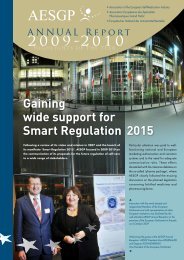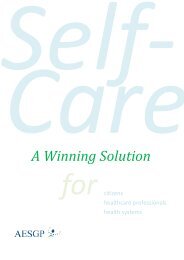Herbal medicinal products in the European Union - AESGP
Herbal medicinal products in the European Union - AESGP
Herbal medicinal products in the European Union - AESGP
Create successful ePaper yourself
Turn your PDF publications into a flip-book with our unique Google optimized e-Paper software.
ibliographic registration dossier for a herbal <strong>medic<strong>in</strong>al</strong> product that meets <strong>the</strong> requirements<br />
of Article 1 of Council Directive 75/318/EEC.<br />
For bibliographic documentation on cl<strong>in</strong>ical efficacy of an extract, <strong>the</strong> MEB is of <strong>the</strong> op<strong>in</strong>ion<br />
that all extracts are not equivalent. Therefore <strong>the</strong>re must be similarity between <strong>the</strong> extract<br />
described <strong>in</strong> <strong>the</strong> support<strong>in</strong>g literature and <strong>the</strong> herbal <strong>medic<strong>in</strong>al</strong> product <strong>in</strong> <strong>the</strong> application.<br />
Portugal<br />
Reference to literature is <strong>in</strong> pr<strong>in</strong>ciple accepted.<br />
Spa<strong>in</strong><br />
Accord<strong>in</strong>g to Royal Decree 767/1993 [SP 3], pharmacological, toxicological and cl<strong>in</strong>ical<br />
studies may <strong>in</strong> pr<strong>in</strong>ciple for non-prescription <strong>medic<strong>in</strong>al</strong> <strong>products</strong> be replaced by<br />
bibliographic documentation. Accord<strong>in</strong>g to <strong>in</strong>formation from <strong>the</strong> Directorate General of<br />
Pharmacy and Sanitary Products, it is sufficient <strong>in</strong> case of herbal <strong>medic<strong>in</strong>al</strong> <strong>products</strong> to<br />
make reference to a monograph.<br />
Sweden<br />
Accord<strong>in</strong>g to <strong>the</strong> MPA’s Guidel<strong>in</strong>es on market<strong>in</strong>g authorisation for natural remedies (LVFS<br />
1995:18) [S 1], regard<strong>in</strong>g safety consideration should primarily be given to experience with<br />
<strong>the</strong> use of <strong>the</strong> product or its constituents, and it should be demonstrated that no harmful<br />
effects have been reported or are be<strong>in</strong>g suspected. If satisfactory proof of safety is not<br />
provided, this should be established by means of cl<strong>in</strong>ical trials and/or pharmacological and<br />
toxicological studies. Even if <strong>the</strong> experience of long-term use of a natural remedy does not<br />
<strong>in</strong>dicate that it has any harmful effects, this cannot always be assumed to be proof of <strong>the</strong><br />
remedy’s safe use.<br />
By def<strong>in</strong>ition, natural remedies may only be marketed with <strong>in</strong>dications for diseases or<br />
symptoms of diseases which are temporary or mild <strong>in</strong> nature, i.e. for diseases or conditions<br />
that are suitable for self-medication. The fields that may be approved for natural remedies at<br />
a later date depend on <strong>the</strong> support<strong>in</strong>g documentation provided <strong>in</strong> <strong>the</strong> application.<br />
For well-documented <strong>in</strong>gredients or <strong>products</strong> for which <strong>the</strong>re is adequate experience, reliable<br />
bibliographic data may be sufficient to support statements about a natural remedy’s efficacy.<br />
However, <strong>the</strong> precondition is that <strong>the</strong> product’s formulation, use and dosage, etc. do not<br />
deviate from those traditionally described. In cases where <strong>the</strong> product’s properties deviate<br />
from <strong>the</strong> traditional description, <strong>the</strong> application is to be supplemented by specific productrelated<br />
documentation <strong>in</strong> accordance with <strong>the</strong> MPA’s Guidel<strong>in</strong>es on <strong>the</strong> documentation of<br />
natural remedies, Part IV, efficacy documentation.<br />
A specific statement on traditional use should be <strong>in</strong>cluded <strong>in</strong> <strong>the</strong> label.<br />
United K<strong>in</strong>gdom<br />
In pr<strong>in</strong>ciple, <strong>the</strong> MCA accepts bibliographic proof of efficacy under 4.8 (a) (ii) for all herbal<br />
<strong>medic<strong>in</strong>al</strong> <strong>products</strong>, but this has to satisfy all <strong>the</strong> requirements of Council Directives<br />
75/318/EEC and 75/319/EEC. For <strong>products</strong> well-established <strong>in</strong> <strong>the</strong> United K<strong>in</strong>gdom, <strong>the</strong><br />
applicant has to submit <strong>the</strong> actual documentation (i.e. provide <strong>the</strong> MCA with copies of <strong>the</strong><br />
documents, not only refer to it). Documents have to be <strong>in</strong> English, o<strong>the</strong>rwise <strong>the</strong>y have to be<br />
translated. The full package should be provided, and <strong>the</strong>re must be an expert report. For<br />
<strong>products</strong> not already licensed <strong>in</strong> <strong>the</strong> United K<strong>in</strong>gdom, <strong>the</strong> application is treated as a New<br />
Chemical Entity (NCE).<br />
The problem of <strong>the</strong> bibliographic proof of efficacy under Article 4.8 (a) (ii) of Council<br />
Directive 65/65/EEC is <strong>the</strong> concept of essential similarity.<br />
Summary<br />
The option of bibliographic application is available <strong>in</strong> <strong>the</strong> follow<strong>in</strong>g Member States:<br />
Country Option of bibliographic application<br />
Austria Yes - only for safety documentation<br />
Belgium Yes - <strong>in</strong> pr<strong>in</strong>ciple<br />
42




